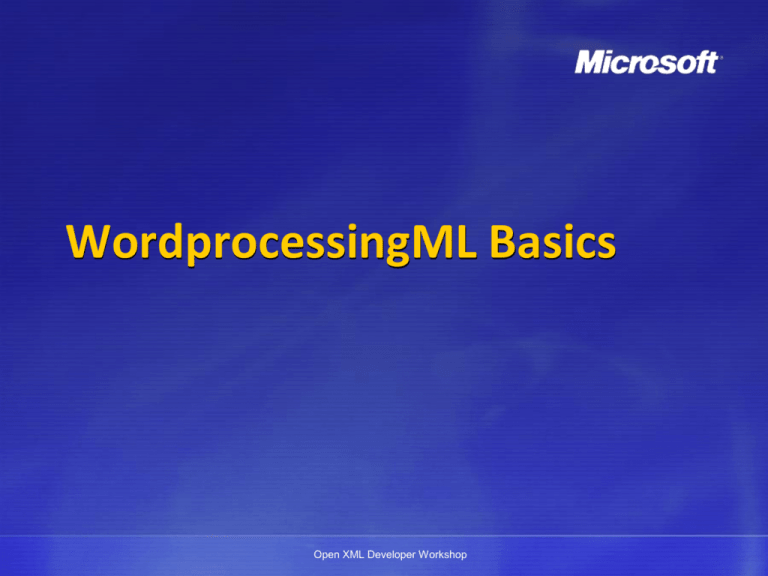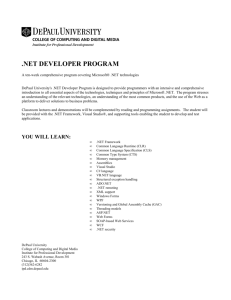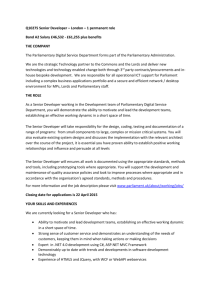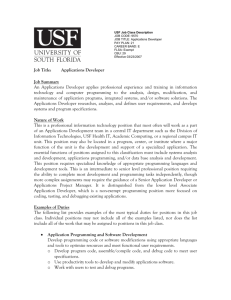
WordprocessingML Basics
Open XML Developer Workshop
Disclaimer
The information contained in this slide deck represents the current view of Microsoft Corporation on the issues discussed as of the date of
publication. Because Microsoft must respond to changing market conditions, it should not be interpreted to be a commitment on the
part of Microsoft, and Microsoft cannot guarantee the accuracy of any information presented after the date of publication.
This slide deck is for informational purposes only. MICROSOFT MAKES NO WARRANTIES, EXPRESS, IMPLIED OR STATUTORY, AS TO THE
INFORMATION IN THIS DOCUMENT.
Complying with all applicable copyright laws is the responsibility of the user. Without limiting the rights under copyright, no part of this slide
deck may be reproduced, stored in or introduced into a retrieval system, or transmitted in any form or by any means (electronic,
mechanical, photocopying, recording, or otherwise), or for any purpose, without the express written permission of Microsoft
Corporation.
Microsoft may have patents, patent applications, trademarks, copyrights, or other intellectual property rights covering subject matter in this
slide deck. Except as expressly provided in any written license agreement from Microsoft, the furnishing of this slide deck does not give
you any license to these patents, trademarks, copyrights, or other intellectual property.
Unless otherwise noted, the example companies, organizations, products, domain names, e-mail addresses, logos, people, places and events
depicted herein are fictitious, and no association with any real company, organization, product, domain name, email address, logo,
person, place or event is intended or should be inferred.
© 2006 Microsoft Corporation. All rights reserved.
Microsoft, 2007 Microsoft Office System, .NET Framework 3.0, Visual Studio, and Windows Vista are either registered trademarks or
trademarks of Microsoft Corporation in the United States and/or other countries.
The names of actual companies and products mentioned herein may be the trademarks of their respective owners.
Open XML Developer Workshop
Objectives
This module covers the essentials of creating and reading
WordprocessingML documents:
Document architecture
The main document part
Paragraphs, runs, text
Images
Hyperlinks
Tables
Open XML Developer Workshop
WordprocessingML Document Architecture
Document
body
properties
A WordprocessingML file is a
collection of multiple “stories”:
comments
images
footnotes/endnotes
numberingDefinitions
headers/footers
styles
fontTable
customXML
The main story
Header(s) / Footer(s)
Footnote(s) / Endnote(s)
Subdocuments
Comment(s)
Open XML Developer Workshop
MAIN DOCUMENT PART
Open XML Developer Workshop
Main Document Part
The top-level element in the start part (e.g.,
document.xml) is document
Document has two optional child elements:
The background element, which specifies the settings for
the background for the document
The body element, which contains the content of the main
story
Open XML Developer Workshop
Block-level Elements
The body element contains the main document story,
made up of block-level elements:
Paragraphs
Tables
Custom XML markup
Alternate format chunks
Subdocuments
Final section properties
Future extensibility containers
Nested elements: a table may contain a table which
contains a paragraph, etc.
Open XML Developer Workshop
Inline Structures
The <w:p> paragraph element contains inline structures:
Runs (containing <w:t> text regions)
Custom Markup (can occur at block or inline level)
Annotations (comments, tracked changes,
bookmarks)
DrawingML elements
Fields (date, page number, document creator, etc.)
Hyperlinks
Open XML Developer Workshop
PARAGRAPHS, RUNS, AND TEXT
Open XML Developer Workshop
Paragraphs <w:p>
The most basic unit of a WordprocessingML document
Contains three pieces of information:
Paragraph properties
Inline content
optional revision IDs used for document merge and compare
A paragraph may occur at any location which allows
block level content:
At the top-most level within a story (e.g. header, footer, main
document)
Nested within a table cell
Nested within a structured document tag or annotation markers
Open XML Developer Workshop
Paragraph Properties
Can be set directly on a paragraph (below)
or in a paragraph style
24 total property settings
<w:p>
<w:pPr>
<w:widowControl w:val=“on” />
<w:keepNext/>
<w:keepLines/>
<w:pageBreakBefore/>
<w:suppressLineNumbers />
<w:suppressAutoHyphens />
<w:textBoxTightWrap />
</w:pPr>
… runs, paragraph content …
</w:p>
Open XML Developer Workshop
Runs <w:r>
A run is a region of text with a common set of properties
All text must be contained within runs
All runs must be contained within paragraphs
A run contains three types of information:
Run properties
Run content (text, fields, soft line breaks, pictures, etc.)
Optional revision IDs for document comparison
Open XML Developer Workshop
Run Properties
Define formatting for
individual characters
Font attributes, size/position, etc.
24 total properties
<w:r>
<w:rPr>
<w:rFonts w:ascii=“Arial” w:hAnsi=“Arial” w:cs=“Arial” />
<w:b/>
<w:i/>
<w:sz w:val=“11” />
<w:dstrike w:val=“true” />
Open XML Developer Workshop
Run Content
Runs may contain various inline structures:
Text
Deleted text
Soft line breaks
Field codes, deleted field codes
Footnote/endnote reference marks
Fields: page numbers, dates, document properties, etc.
Tabs
Ruby text
DrawingML content
Embedded objects
Pictures
Open XML Developer Workshop
Paragraph Example
Simple text formatting at the run level:
<w:p>
<w:r>
<w:t>The quick</w:t>
</w:r>
<w:r>
<w:rPr>
<w:i/>
</w:rPr>
<w:t>brown</w:t>
</w:r>
<w:r>
<w:t>fox.</w:t>
</w:r>
</w:p>
Run properties specify italics
Open XML Developer Workshop
Text <w:t>
This is the only element in the main story that can
contain text – all other text is in attribute values
Three other types of text are allowed in runs:
Deleted text <w:delText>
Field code <w:instrText>
Deleted field codes <w:delInstrText>
Text nodes contain the displayed text and nothing more
This simplifies search, localization, and similar tasks
Open XML Developer Workshop
Searching Open XML text
To create a simple text search utility:
• Use XmlReader.Create() factory pattern
• Looks only to the <w:t> nodes
• Extremely fast and simple
Open XML Developer Workshop
Run/Text Structure: Not Predictable
• Producers may break run/text elements arbitrarily
• Never assume anything about run/text structure!
<w:p>
<w:r>
<w:t>These examples are functionally identical.</w:t>
</w:r>
</w:p>
<w:p>
<w:r>
<w:t xml:space=“preserve”>These </w:t>
<w:t xml:space=“preserve”>examples </w:t>
</w:r>
<w:r>
<w:t xml:space=“preserve”>are </w:t>
<w:t xml:space=“preserve”>functionally </w:t>
</w:r>
<w:r>
<w:t>identical.</w:t>
</w:r>
</w:p>
Open XML Developer Workshop
Fields
A sample of another type of inline content
Fields are auto-filled by the application when the
document is opened
<w:p>
<w:fldSimple w:instr=" DATE
</w:p>
\@ &quot;d MMMM yyyy&quot;
\* MERGEFORMAT“/>
77 total field types
Examples: author, date, createdate, page#, time, formula
DEMO
Open XML Developer Workshop
Revision IDs (RSIDs)
RSID values are used to identify a set of changes that
were made during the same editing session
Found in many elements:
Paragraphs, runs, sections, styles
Table rows, table properties, charts, diagrams
Optional, but recommended for applications that modify
existing documents
Sample revision IDs table (from settings part):
<w:rsids>
<w:rsidRoot w:val="008142D8" />
<w:rsid w:val="00102433" />
<w:rsid w:val="008142D8" />
<w:rsid w:val="00903906" />
</w:rsids>
Open XML Developer Workshop
DEMO
IMAGES AND HYPERLINKS
Open XML Developer Workshop
Images
An image is a w:pict element inside a run <w:r>
The v:imagedata element is defined in VML:
xmlns:v="urn:schemas-microsoft-com:vml"
The actual image is referenced via a relationship:
<w:pict>
<v:shape id="_x0000_i1025" type="#_x0000_t75" style="width:250; height:200">
<v:imagedata r:id="rId4"/>
</v:shape>
</w:pict>
The relationship points to an image part in the package:
<Relationship Id="rId4”
Type="http://schemas.openxmlformats.org/officeDocument/2006/relationships/image”
Target="image1.jpg"/>
Open XML Developer Workshop
Hyperlinks
A hyperlink is nested inside a paragraph, outside a run:
<w:p>
<w:hyperlink r:id=“linkRel1">
<w:r>
<w:rPr>
<w:color w:val="0000FF" w:themeColor="hyperlink" />
<w:u w:val="single" />
</w:rPr>
<w:t>Click here for OpenXmlDeveloper.org.</w:t>
</w:r>
</w:hyperlink>
</w:p>
The destination is stored in a relationship:
<Relationship Id=“linkRel1“
Type="http://schemas.openxmlformats.org/officeDocument/2006/relationships/hyperlink”
Target="http://www.openxmldeveloper.org" TargetMode="External" />
DEMO
Open XML Developer Workshop
Hyperlink Destinations
Hyperlinks can link to three types of destinations:
Intradocument: a bookmark contained within the current
WordprocessingML document.
Interdocument: another WordprocessingML package;
may optionally specify a bookmark within that package.
Other destinations: any other valid URI location, such as
the web-page example shown previously.
Open XML Developer Workshop
WORDPROCESSINGML TABLES
Open XML Developer Workshop
Tables
Tables are a set of paragraphs which are arranged into
rows and columns
In WordprocessingML, tables are block level content, and
are specified using the tbl element
Analogous to the HTML <table> element
Open XML Developer Workshop
What’s in a WordprocessingML table?
Four types of content:
Properties
Grid
Rows
Cells
<w:tbl>
<w:tblPr>
<w:tblStyle w:val=“TableGrid”/>
<w:tblW w:w=“0” w:type=“auto”/>
<w:tblLook w:val=“01E0”/>
</w:tblPr>
<w:tblGrid>
<w:gridCol w:w=“2952”/>
<w:gridCol w:w=“2952”/>
<w:gridCol w:w=“2952”/>
</w:tblGrid>
<w:tr>
<w:tc>
<w:tcPr>
<w:tcW w:w=“2952” w:type=“dxa”/>
</w:tcPr>
<w:p>
<w:r>
<w:t>1,1</w:t>
</w:r>
</w:p>
</w:tc>
<w:tc>
<w:tcPr>
<w:tcW w:w=“2952” w:type=“dxa”/>
</w:tcPr>
<w:p>
<w:r>
<w:t>1,2</w:t>
</w:r>
</w:p>
</w:tc>
</w:tr>
</w:tbl>
DEMO
Open XML Developer Workshop
Table Properties
The tblPr section specifies
various properties that
apply to the entire table
<w:tblPr>
<w:tblStyle w:val=“TableGrid”/>
<w:tblW w:w=“0” w:type=“auto”/>
<w:tblLook w:val=“01E0”/>
</w:tblPr>
• Sizing , alignment, text wrap
• Table styles (rows/columns per band,
conditional formatting flags)
• Borders, cell margins, shading
• Table property revisions
Open XML Developer Workshop
Table Rows <w:tr>
The <w:tr> element defines a table row
Analogous to the HTML <tr> tag
Table rows can contain:
Table row properties
Custom XML markup
Table cell content
<w:tbl>
<w:tblPr/>
<w:tblGrid/>
<w:tr>
… row content …
</w:tr>
<w:tr>
… row content …
</w:tr>
</w:tbl>
Open XML Developer Workshop
Table Row Properties <w:trPr>
Overrides various properties for this row:
Row height
Breaking across pages
Conditional formatting
Many other properties
<w:trPr>
<w:trHeight w:val=“144”/>
<w:cantSplit />
</w:trPr>
Open XML Developer Workshop
Table Cells <w:tc>
The tc element defines the contents of a table cell
Analogous to the HTML <td> tag
Table cells can contain:
Cell properties
Any block-level content
Table cells must contain at
least one paragraph, even
if it’s empty
<w:tbl>
<w:tblPr/>
<w:tblGrid/>
<w:tr>
<w:tc>
… cell content …
</w:tc>
<w:tc>
… cell content …
</w:tc>
</w:tr>
</w:tbl>
Tables may be nested
Open XML Developer Workshop
Table Cell Properties <w:tcPr>
Overrides various properties for cell values:
•
•
•
•
•
Preferred width
Vertical alignment
Cell margins
Text wrap
Many other properties
<w:tcPr>
<w:tcW/>
<w:vAlign/>
<w:tcMar/>
<w:noWrap/>
</w:tcPr>
Open XML Developer Workshop
Table Layout Concepts
Table layout is determined by multiple properties:
The table grid
Table-level properties (example: preferred width)
Row-level properties (example: indentation before/after)
Cell-level properties (example: preferred width)
These properties may contradict one another, and it is
the responsibility of the consuming application to resolve
those conflicts
The table must satisfy the grid at all times
Open XML Developer Workshop
AutoFit Table Layout
An AutoFit table dynamically resizes to fit its content
The resizing algorithm that Office uses is based on the
published W3C spec for table AutoFit, with provisions for
gridBefore/gridAfter
Open XML Developer Workshop
Vertical Cell Merges
So far, we've looked at tables as if they have strict
definitions of rows
But cells can span multiple rows:
Vertically merged cell
Open XML Developer Workshop
Vertical Cell Merges
Cells are merged vertically using the vmerge element
A vMerge element of type "restart" begins or restarts a vertically
merged region
A vMerge element of type "continue" continues a vertical merge
(Word uses “continue” as the default for vMerge type)
Cells in the same grid column after a “restart” are
merged vertically until the last “continue”
Only the contents of the first cell are rendered – the
other cells don’t exist after the merge
DEMO
Open XML Developer Workshop
Open XML Developer Workshop




![[#CARBON-13743] Key store password of catalina](http://s3.studylib.net/store/data/007841975_2-b5be293be17dfbfd4fa5374476b625ea-300x300.png)



